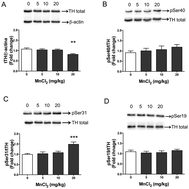Tyrosine hydroxylase regulation in adult rat striatum following short-term neonatal exposure to manganese†
Abstract
Manganese (Mn) is an essential trace element required for a range of physiological processes, but Mn can also be neurotoxic especially during development. Excess levels of Mn accumulate preferentially in the striatum and can induce a syndrome called manganism, characterized by an initial stage of psychiatric disorder followed by motor impairment. In the present study, we investigated the effects of Mn exposure on the developing dopaminergic system, specifically tyrosine hydroxylase (TH) protein and phosphorylation levels in the striatum of rats. Neonatal rats were exposed to Mn intraperitoneally (ip) from post-natal day 8 up to day 12 (PND8–12). Striatal tissue was analysed on PND14 or PND70, to detect either short-term or long-term effects induced by Mn exposure. There was a dose dependent increase in TH protein levels in the striatum at PND14, reaching significance at 20 mg kg−1 Mn, and this correlated with an increase in TH phosphorylation at serines 40, 31 and 19. However, in the striatum at PND70, a time by which Mn levels were no longer elevated, there was a dose dependent decrease in TH protein levels, reaching significance at 20 mg kg−1 Mn, and this correlated with TH phosphorylation at Ser40 and Ser19. There was however a significant increase in phosphorylation of TH at serine 31 at 20 mg kg−1 Mn, which did not correlate with TH protein levels. Taken together our findings suggest that neonatal Mn exposure can have both short-term and long-term effects on the regulation of TH in the striatal dopaminergic system.

- This article is part of the themed collection: Neurochemistry of lead and manganese

 Please wait while we load your content...
Please wait while we load your content...